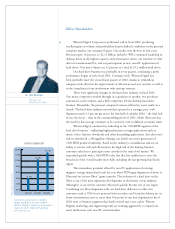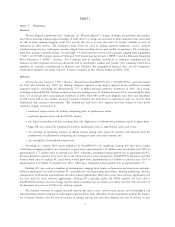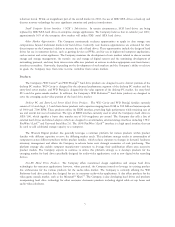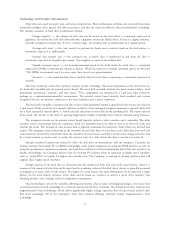Western Digital 2002 Annual Report Download - page 13
Download and view the complete annual report
Please find page 13 of the 2002 Western Digital annual report below. You can navigate through the pages in the report by either clicking on the pages listed below, or by using the keyword search tool below to find specific information within the annual report.For an additional discussion of the need to adapt to customers' business models and maintain customer satisfaction,
refer to Part II, Item 7, under the headings ""Risk factors related to the hard drive industry in which we operate'' and
""Risk factors related to Western Digital particularly.''
Distributors. The Company uses a select group of distributors to sell its products to small computer manufacturers,
resellers, dealers and systems integrators. The Company's major distributor customers include ASI, COS Distribu-
tion AG, eSys Distribution, Genuine, Ingram Micro and Synnex. Distributors accounted for approximately 39%, 45%
and 38% of disk drive revenues for 2002, 2001 and 2000, respectively. Distributors generally enter into non-exclusive
agreements for speciÑc territories with the Company for purchase and redistribution of product on a quick turnover basis.
Purchase orders are placed and revised on a weekly basis. The Company grants certain of its distributors price protection
and limited rights to return product on an inventory rotation basis.
Retailers. The Company sells its retail-packaged products directly to a select group of major retailers such as
computer superstores, warehouse clubs and computer electronics stores, and authorizes sales through distributors to
smaller retailers. Major retailers to whom the Company sells directly include Best Buy, Circuit City, CompUSA, Fry's
Electronics and Sam's Club. Retailers accounted for approximately 7% of revenues for each of 2002, 2001 and 2000. The
Company's current retail customer base is primarily in the United States, Canada and Europe. The retail channel
complements the Company's other sales channels while helping to build brand awareness for the Company and its
products. Retailers supply the aftermarket ""upgrade'' sector in which end-users purchase and install products to upgrade
their computers. The Company grants certain of its retailers price protection and limited rights to return product on an
inventory rotation basis. The Company also sells its retail-packaged products through the Internet, at its website.
The Company maintains sales oÇces throughout North America, Eastern and Western Europe, the Middle East,
Japan and Asia/PaciÑc. Field application engineering is provided to strategic computer manufacturer accounts, and
localized end-user technical support services are provided within the United States, Canada and Europe. The Company's
localized end-user technical support is currently supplied by employees through telephone support and via the Company's
website.
The Company's international sales, which include sales to foreign subsidiaries of U.S. companies but do not include
sales to U.S. subsidiaries of foreign companies, represented 50%, 47% and 50% of revenues for 2002, 2001 and 2000,
respectively. Sales to international customers may be subject to certain risks not normally encountered in domestic
operations, including exposure to tariÅs, various trade regulations and Öuctuations in currency exchange rates. See Part II,
Item 7, under the heading ""Risk factors relating to Western Digital particularly.''
For additional information concerning revenue recognition, sales by geographic region and signiÑcant customer
information, see Notes 1 and 9, respectively, of the Notes to Consolidated Financial Statements.
The Company's marketing and advertising functions are performed both internally and through an outside Ñrm.
Advertising, worldwide packaging and marketing materials are targeted to various reseller and end-user segments.
Western Digital utilizes both consumer media and, to a lesser extent, trade publications. The Company has programs
under which qualifying distributors and retailers are reimbursed for certain marketing expenditures. Western Digital also
maintains customer relationships by communicating with its resellers and providing end-users with pre-sale and post-sale
information and support through its website.
Competition
In the desktop hard drive market, the Company has competed primarily with Fujitsu, IBM, Maxtor, Quantum,
Samsung and Seagate. Over the last two years, Maxtor acquired the hard drive business of Quantum, Fujitsu exited the
desktop hard drive market, and IBM exited the 5400 RPM segment of the hard drive market, decreasing the number of
major competitors. In addition, IBM announced in April 2002 that it will sell its hard drive business to a joint venture
that is controlled by Hitachi Data Systems.
The hard drive industry is intensely competitive, with hard drive suppliers competing for sales to a limited number
of major customers. Hard drives manufactured by diÅerent competitors are highly substitutable due to the industry
mandate of technical form, Ñt and function standards. Hard drive manufacturers compete on the basis of product quality
and reliability, storage capacity, unit price, product performance, production volume capabilities, delivery capability,
leadership in time-to-market, time-to-volume and time-to-quality, service and support, and ease of doing business. The
8
























